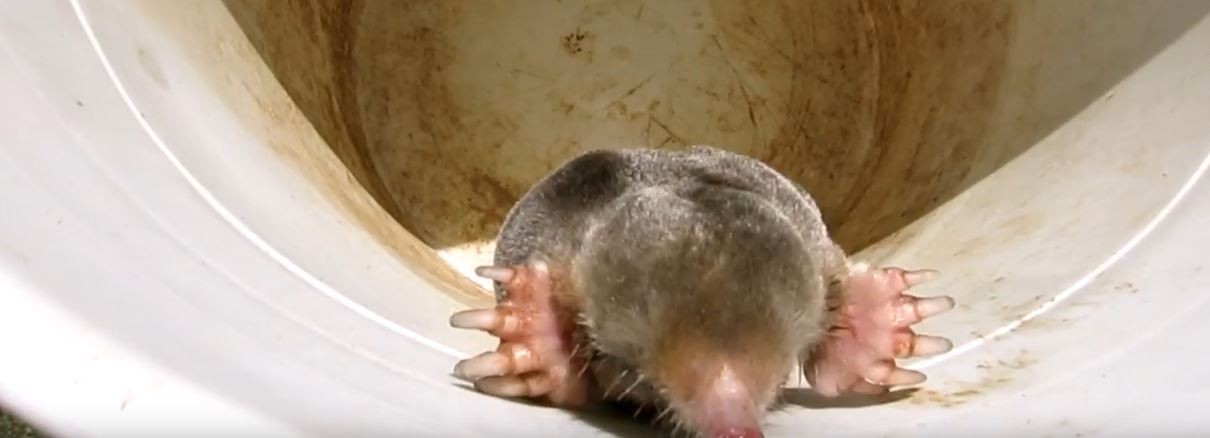About Mole: Appearance, Biology, Life Cycle, Habitat, Diet, Behavior

Moles are one of the many animals that can cause some serious problems on your property if you aren't careful. They will dig up dirt on your lawn to create their burrows and turn a well-landscaped area into a less aesthetically-pleasing area. By learning a bit about these animals, you will better understand what they are doing on your property and be on the path to prevention and mole removal.
Appearance
Moles may be small, but anyone who has experience with them will tell you that they are very destructive. They usually measure between five and eight inches in length and will weigh between three and five ounces. These animals have very small eyes and ears, but these features are not typically visible through the velvety, short fur.
Moles' feet have evolved to help them more efficiently move dirt and the webbing lets them “swim” through the soil as if their feet were paddles.
Biology And Life Cycle
Most people think that moles are rodents, but this is not actually the case despite their rodent-like appearance. The average mole lives two to six years. The life span will vary based on the number of predators in an area and the type of mole. Those who live in sandy soil, for example, tend to have shorter life spans. This is because sandy soil increases the rate at which their teeth break down and this eventually makes it harder for the animals to eat.
Because moles live underground, most people aren't surprised to learn that these creatures are not very social. Mating season begins in the early spring and this is the only time of the year that moles are social. During the season, males will seek out the females, wait for fertilization, and then search for other females. The gestation period will last four to six weeks at which point a litter of two to seven babies is born. Although they are hairless when born, they are typically weaned by four or five weeks. These babies will grow quickly and leave home within a short period of time, usually around mid-April to late June. At this point, they are vulnerable to predators such as domesticated animals, owls, coyotes, and raccoons. Moles typically only have one litter each year after they reach sexual maturity around 10 months of age.
Habitat
There are several different species of moles and the exact habitat preference will vary among them. In the majority of cases, they will very rarely be seen above ground, instead preferring to remain below. Moles will typically create a nest immediately below the surface of the ground with their tunnels going down to a depth of about 12 inches.
The nesting chamber where moles give birth is slightly different. It will typically be underneath a man-made obstacle, tree, or large stone and be 5 to 18 inches under the ground. The nest itself should be similar in size to a quart jar.
The range of mole species means they can be found in many areas. The Star-Nosed Mole, for example, prefers to live in moist environments such as marshes, bogs, and meadows. The Eastern Mole, on the other hand, prefers dry soil like that in fields, woodlands, and meadows. There is a common theme among mole habitats regardless of species; they will easily adapt to their surroundings and search for soil that is easy to pass through and has a rich amount of food.
Diet
This is a type of animal that will eat an enormous quantity of food. In fact, a single mole will generally eat between 70 and 100 percent of its body weight in food daily. Because they eat so much, it should come as no surprise that they will dig anywhere up to 150 feet worth of tunnels daily to look for food.
Moles prefer to eat earthworms and this insect accounts for about 85 percent of a typical mole diet. They also enjoy eating other small invertebrates that live underground, such as beetles, grubs, and snails.
Behavior
Moles tend to spend nearly their entire lives underground. This is why they dig up lawns and gardens; they are living there and searching for food. The majority of molehills and ridges are found along the top 6 or 12 inches of soil since this is where the animals are most likely to find a source of food. In the winter months, they tend to dig deeper than this since their food will be found farther underground.
Moles will remain active all year round and during most of the day and night. They must remain active throughout the year since they cannot store fat or food. Despite this, you will see the most activity during the spring or fall. Keep in mind that moles have a large home range and can be active in an area of up to an entire acre.
Read the How to get rid of moles page for helpful information and to learn more about About Mole: Appearance, Biology, Life Cycle, Habitat, Diet, Behavior

